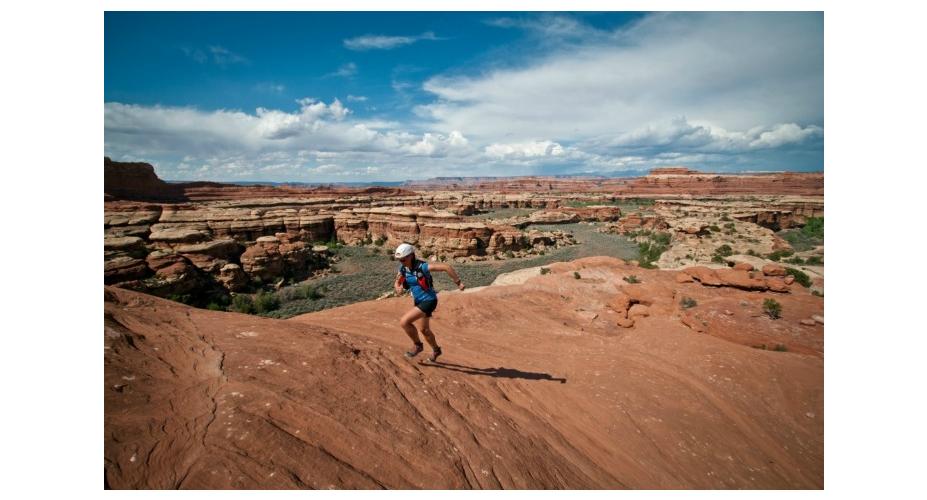
As a convenient, effective way to get in shape while relieving stress, road running is an ideal workout. But many women (and men) have found nirvana in a quickly growing offshoot of the sport: trail running. Once considered a burly, unorthodox cousin, trail running has achieved mainstream status among runners, and it's no surprise why: Soaking up the serenity of the trails works wonders for stress, develops a whole different level of fitness, and it’s a ton of fun.
While long runs on the road offer a classic cardio burn, as well as providing other does-a-body-good benefits like reducing the risk of heart disease, diabetes, osteoporosis, and breast cancer, a speedy trek on the trails promises all those and more. Navigating the obstacles of the trail—rock gardens, root-covered forest floors, steep climbs, and slick descents—utilizes a wider set of muscle groups and requires more mobility and agility than simply running in a straight line along pavement.
It also sharpens the senses, as you have to keep a close eye on every step. For example, jogging with girlfriends on your usual route through the neighborhood, it’s a cinch to adjust your ponytail or make eye contact while you’re chatting. Do that on the trail, however, and you may easily find yourself face-planted thanks to that moss-covered root you didn’t see. Keeping an ear tuned to the sounds of a mountain biker bombing down the trail and inhaling the fresh scent of the forest add to the sense of escapism. As many runners also attest, running trails also inspires a newfound appreciation for the natural beauty of a place.
And then, there are the physical pluses: Thanks to the hills and constant obstacles your body must respond to, trail running shapes muscles and strengthens the core in a way that road running and jogging just can’t. As Women's Health Month kicks off, here’s how to kick your fitness routine into a new gear by heading off the beaten path.
Pick the Perfect Pair

First things first: An investment in trail shoes will pay for itself over and over again in injury prevention and overall enjoyment of the sport. Trail-specific shoes have a lower profile than regular running shoes, meaning they’re lower to the ground and don’t have the typically higher heel of regular running shoes to reduce the chance of rolling your ankle. In addition, they feature rugged tread that offers better traction on wet, muddy trails.
When you’re deciding on a pair, keep in mind that they should fit snugly in the heel but have room in the toe box. Purchasing your first trail shoes from a specialized running store is highly recommended, as staff will assess your gait and help you pick out a pair specially designed for your foot, heel strike, and all sorts of other running specifics that the pros love to geek out on.
Leave Your Ego at Home

As with any new workout routine, it's important to start out slow Ryan Smith
Newbie trail runners often experience a humbling intro to the sport: It’s significantly slower going on the trails than the road, especially at first. In other words, don’t expect to finish a five-mile run on dirt as quickly as you can during your regular route around the neighborhood. You may add on as many as 40 more minutes (or more) depending on the difficulty of the route. Don’t be afraid to walk, either: Even the most hardcore ultrarunners in the world walk up (or down) the really steep stuff. When it doubt, walk it out.
And, as with any new workout routine, start slow: Don’t try to knock out a 10-miler on your first foray on the trails. Going with a girlfriend who knows the trails is a perfect way to get acquainted with routes. If you’re going by yourself, choosing an out-and-back option is ideal for getting an idea of your pacing on the trails while you gain confidence, too.
Prepare for a Whole-Body Workout
The beauty (and the beast) of trail running is the uneven ground. Hitting the trails (and the steps, hills, and scrambles) develops proprioception, the body’s unconscious ability to respond quickly to outside stimuli.
“When you land on uneven terrain, sensory receptors send signals to the brain, which help the muscle groups react. As you continue trail running, you will develop increased balance and quicker reflexes,” write Kirsten Poulin, Stan Swartz, and Christina Flaxel in their book Trail Running: From Novice to Master.
With better balance, ankles strengthen and become less prone to sprains. Quadriceps, hamstrings, and calf muscles all become stronger and more defined by running up and over hills, too. And adding in strength and balancing exercises like lunges and single-leg squats is a great way to complement your trail runs. A wobble board, for example, can work wonders in developing ankle strength.
HIIT the Trails

No sane person really likes running hills.... but they'll get you into shape fast Ryan Smith
High intensity interval training, or HIIT, has become one of the most popular ways to burn fat and get in serious shape. It involves alternating short bursts of minutes of intense effort with the same amount of low-to-moderate effort over a longer period of time. But you can also HIIT the trail (get it?) by adding some hill repeats into your run.
Find a moderate incline that takes two to four minutes to crest with a hard charge and repeat that six to eight times (if you’re just starting out, you might choose a shorter incline). Simply choosing a hilly route, one that’s sprinkled with lots of hills in between flatter stretches or descents, is another way to work in a higher intensity aspect to your run.

